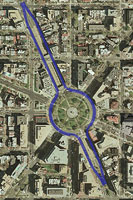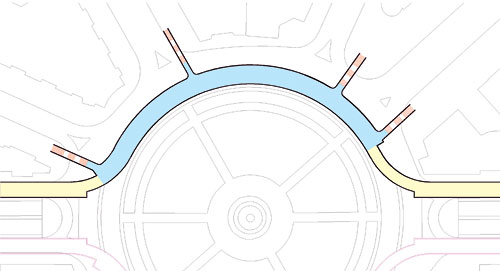Artists still waiting to revitalize Dupont Underground

Dupont’s tunnels.
Beneath Dupont Circle lie two long, dank tunnels that were once a bustling underground streetcar station. A coalition of arts groups want to reactivate the space for arts exhibition and performance, but they need community support and action from the Deputy Mayor’s office.
The tunnels became empty in 1962, as DC was dismantling its streetcar system. Today, the only remnant is the many covered staircases surrounding the circle, which now look more like utility shafts. In 1995, one developer tried to turn the space into a food court, but that project failed quickly and morphed into drawn-out litigation. As reported a year ago, a number of arts groups have banded together to propose renovating the space into a shared arts exhibition and performance space.
Arts space could succeed where fast food failed. Food establishments rely on foot traffic for much of their patronage, and a dark, cavernous underground tunnel is not exactly the ideal dining space. The tunnel is curved, reducing sight lines. But exhibitions and performances typically don’t want outside light, and people travel to them purposefully rather than happening by.

Concept sketch for Dupont Underground. Image from Hunt Laudi Studio.
What’s the holdup? The organization, the Arts Coalition for Dupont Underground, has been waiting for city government to release an RFP for a new lease. Initially, an outstanding contract mandated that only adjacent property owners could bid for the space, according to coalition representative Adam Griffiths. But, of course, the adjacent owners already have space on Dupont Circle, and aren’t necessarily interested in this. The DC Council passed a law voiding that requirement, but the Office of the Deputy Mayor for Planning and Economic Development has still not moved ahead.
Recently, DMPED officials also told Griffiths and the Coalition that they wanted to conduct community discussions about the future of the space. As a Dupont Circle resident, I think the arts would be a great use for this space where commercial enterprises are unlikely to succeed. Many other residents have expressed enthusiasm for this arts option. It’s worthwhile to also consider other possibilities, but would any work?
Back in 2003, the Dupont Circle ANC discussed potential uses (DOC). Suggestions included a movie theater, DC permit offices, storage for nearby residents, and retail. Some suggested a gay and lesbian museum, but GLBT officials were unenthusiastic about the symbolism of locating a museum underground for a civil rights issue that spent too many decades in the figurative closet.
In any event, DMPED has still also not scheduled community meetings, and the coalition is still waiting for the opportunity to bid and begin real fundraising. If they can secure a lease, the coalition will still face obstacles. The tunnels are in bad shape from years of neglect and the water that inevitably collects in underground spaces unless actively removed. They hope to raise money to renovate a small portion of the space for about $100,000, then begin a capital campaign to fund the remainder of a Phase 1 build-out at a cost of about $500,000.
There are actually two tunnels, one on each side of the circle. The group currently proposed to use the western tunnel, which is closer to more of the existing galleries and the P Street commercial area. The tunnels are also much longer than just surrounding the circle, though all of the entrances are on the circle; they include long, straight segments along Connecticut from R nearly to N Streets. The coalition would use the circular section for programming and small pieces of the straight portions for storage. Conceivably, the eastern tunnel could go to another use, if another company or organization were interested enough and could afford to renovate that space.

Concept plan for Dupont Underground. Image from Hunt Laudi Studio.
